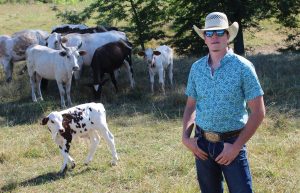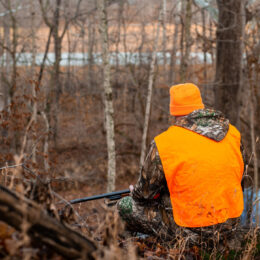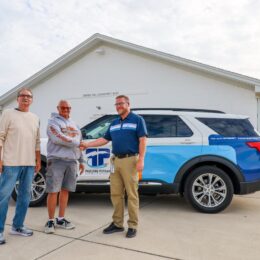 You wouldn’t expect massive bucking bulls to affectionately beg for treats. But when a Professional Bull Riding (PBR) bull brushes his huge, curious nose against your arm, extending a long, grabby wet tongue, you don’t deny him a treat — after all, he’s got his own coveted genetic line at Smith Acres Bucking Bulls farm.
You wouldn’t expect massive bucking bulls to affectionately beg for treats. But when a Professional Bull Riding (PBR) bull brushes his huge, curious nose against your arm, extending a long, grabby wet tongue, you don’t deny him a treat — after all, he’s got his own coveted genetic line at Smith Acres Bucking Bulls farm.
Bull riding has been said to be the eight most dangerous seconds in all of sports. Looking at these massive muscular horned beasts (one appropriately named Lights Out) and their rodeo scorecards, you can’t help but ask the question: Why?
“It was just something I couldn’t shake. I don’t know if it was the Indian in me, or I was just too hard-headed to do anything else,” said owner JR Smith, a Paulding Putnam Electric Cooperative member, giving us a coy smile under his straw cowboy hat and tinted sunglasses. His crisp, collared short-sleeve, a blue floral pattern, draws the eye when paired with his sleek brown boots. “Bull riding has always been a one-man sport, and there’s no excuses. At the end of the day, if you don’t do well, it’s because you didn’t train hard enough.”
The 30-year-old daredevil-turned-family-man was a bull rider for 14 years, making his start in King, North Carolina, before moving to Paulding, Ohio, to become a PBR bull breeder in 2006. Starting with two cows, he kept adding and breeding every year, and the family operation “has just gotten bigger and bigger” every year. Smith Acres is a cow-calf company, meaning Smith breeds cows to create calves, then trains them to be bucking bulls he can sell, lease, or continue to breed, further specializing his genetic line. His herd of 70 cattle roam freely on a 60-acre ranch — of those, 30 are bulls of all ages.
Rodeo bulls have been bred for more than 100 years. But in the last 10 to 15 years, Smith says they are being bred smaller and meaner — not the typical big, scary Western bulls everyone thinks of. These bulls’ rough spins, drops, and kicks prove they have their own registry: fierce genetics aimed at pouring more adrenaline into America’s original extreme sport.
These bucking bulls live a life of luxury, and rightly so — PBR events draw more than 2.5 million people to more than 275 annual events, reaching an additional 500 million through television. Prize money has grown to over $9.5 million annually, and owners breed their retired animals for more money yet. Smith currently has a bull “that’s really kicking butt” at PBR events, and most others are leased to rodeos within a 100-mile radius. But some are sold in Texas or Oklahoma to compete with bull riders around the globe.
“Yes ma’am, they live a very good life. Better than me,” Smith laughed. “Some have chiropractic work done and have swimming pools. They eat every day before I do.”
But breeding is tedious, and Smith admits that when you’re “the little man” in this industry, it’s not the highest-paying gig, as the bulls that don’t work out can’t be sold for near as much as beef steer, like black angus. It’s an expensive, drawn-out process, taking four years from gestation to maturation before a breeder even knows if he might have a winning bucking bull. He’s lucky if half his bulls make the cut, and even if they do, they still have to have immense heart when performing — “something you can see in their eyes.”
Patience is a virtue Smith has learned to nurture. He likes to think of himself as a caretaker to everything in his life, including his six-year-old daughter, two shepherd dogs, a terrier, chickens, and three horses, which he allows to roam freely around the family’s rustic white farmhouse. They joyfully roll in the dirt along the white picket fence, and I can hear whinnying from the rodeo pen in Smith’s front yard. His dogs sit obediently, panting at his feet.
“I can probably be a bit ornery at times,” he said, glancing down to pet the dogs before looking straight up into my eyes. “I lived a wild life, but now that I’m settled down, I want to be a role model for my little girl. When I start something, I finish it; if I tell you I’m going to do it, I do it. I’m proud of my people and my tribe, and I try to wear our name well.”
Smith has proudly worn the Smith Acres name for two years at Paulding County Fair’s annual Rodeo Night, where he works with PPEC and supplies bulls for the bucking competition that raises funds for Conquer Childhood Cancer Now, a local group supporting child cancer patients and their families. Every year, tears are shed at the emotionally charged event where adrenaline and gratitude are tangible in the air. There, his bulls bring large crowds of screaming fans, but you won’t find that at his personal ranch.
His cattle enclosure is a 10-minute drive from the family homestead on a quaint property he calls “Bull Palace.” After a long drive down a stone road, a dilapidated 1830s mansion appears beside the grazing bulls in the field. When Smith’s silver Ford F-250 flatbed truck pulls up, the cattle immediately zone in and mosey toward us, knowing what that truck represents. Princess, a 9-year-old white speckled cow with a black nose and ears leads the herd. She knows her name and the impact her babies have had for this business, so she demands a treat first, poking her head right into the passenger window.
As Smith gets out to introduce them, his large belt buckle catches the light of the morning sun. Apparently, these buckles aren’t merely a fashion statement.
“You have to win them,” he says, showing us his, which is about the size of my palm. It was won at a West Virginia rodeo after his daughter was born and he had unfinished business to pay off. Of the rodeo’s 14 bulls, he rode 11 — and has the buckle and scars to show for it. “They don’t just give these things out for fun. The size of the buckle directly correlates with the win. The bigger, the better.”
Smith doesn’t deny the danger of the sport, revealing the lengthy list of injuries he’s acquired over the years: too many broken bones to count and fingers damaged in every way possible. The worst one?
“I punctured a lung, broke a bunch of ribs, and snapped my clavicle — all in about two seconds,” Smith says. “It’s definitely dragging at times.”
When asked how he stays in shape to handle these forceful mammals, Smith says he does anything and everything to harden his tall, lean stature.
“Push-ups, pull-ups, crunches — you name it. You work as hard as an NFL player to make your body a tool.”
Smith proceeds to get down on one knee and feed two bulls from each hand. Through thick and thin, these bulls are his life and passion. He’s putty in their hooves.
“I think if you stand in the rain long enough, everything pays off, whatever you do in life,” Smith says. “But you have to love it.”
SAMANTHA KUHN is communications specialist at Paulding Putnam EC.
Want to see the footage? Stay tuned for a video featuring member adventures online!
Every month, we are running a story featuring a Paulding Putnam Electric member. If you know someone with an interesting story, cool business, or inspiring tale, please submit your ideas to skuhn@ppec.coop. We would love to feature you or a neighbor in our series, which will include a print story and video on Facebook and www.ppec.coop.



